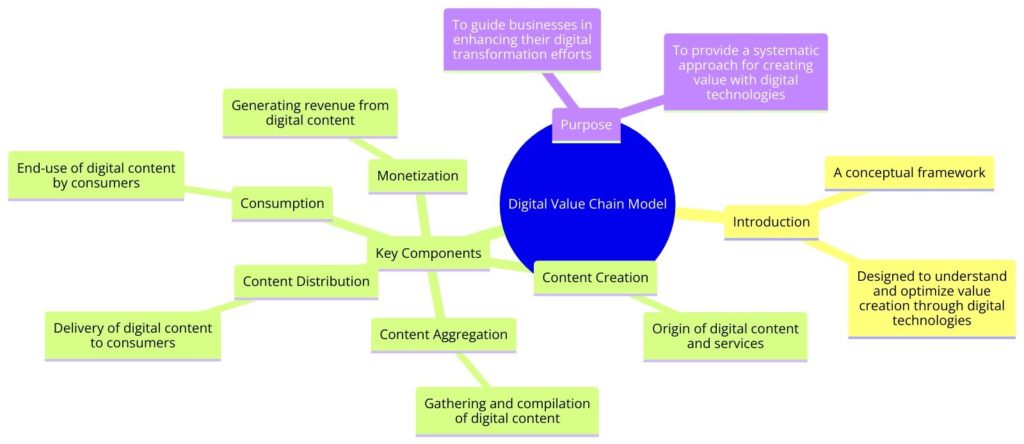Digital Value Chain Model
The Digital Value Chain Model is a conceptual framework designed to understand and optimize the process of creating value through digital technologies. It extends the traditional value chain model, introduced by Michael Porter in 1985, into the digital domain, reflecting the unique characteristics and opportunities presented by digital products, services, and platforms. This model highlights the series of activities that companies undertake to deliver digital goods or services to the market, emphasizing the importance of digital assets, data, and customer interactions.
Origin of the Digital Value Chain Model
While the concept of a digital value chain has been discussed by various academics, consultants, and practitioners, it does not have a single originator like Porter’s traditional value chain model. Instead, it has evolved through the contributions of many, adapting to the rapid development of digital technologies and their impact on business operations and strategies. The model is a collective response to the digital economy’s challenges and opportunities, drawing on insights from across the fields of information technology, digital marketing, and strategic management.
How It Works
The Digital Value Chain Model breaks down the value creation process into digital-specific activities that companies engage in to produce and deliver digital products or services. These activities are typically categorized into primary and support activities, similar to Porter’s original framework, but are redefined to reflect the digital context:
- Content Creation: Involves the development of digital content, such as software, multimedia, or online content, which is crucial for digital goods and services.
- Content Aggregation: Refers to the gathering and compilation of content from various sources to create a comprehensive offering.
- Product Development: Focuses on the design and development of digital products or services, incorporating user experience (UX) and user interface (UI) design principles.
- Distribution: Involves digital channels and platforms to distribute products or services to the end user, including online marketplaces, app stores, and streaming services.
- Marketing and Sales: Utilizes digital marketing techniques, such as social media, email marketing, and search engine optimization (SEO), to promote products and engage with customers.
- Customer Service and Support: Provides after-sales support through digital means, such as chatbots, helpdesks, and online communities, to enhance customer satisfaction and loyalty.
Support activities in the digital value chain include infrastructure management (IT and telecommunications), technology development (innovation in digital technologies), human resource management (skills and knowledge in the digital domain), and procurement (acquiring digital assets and services).
Why It Is Valuable
The Digital Value Chain Model is valuable for several reasons:
- Strategic Insight: It provides businesses with a framework to systematically assess and optimize their digital activities, ensuring that each step adds value to the final product or service.
- Competitive Advantage: By identifying and leveraging digital technologies at each stage of the value chain, companies can differentiate their offerings, enhance customer experiences, and outperform competitors.
- Efficiency and Innovation: The model encourages companies to streamline operations and embrace innovation, leading to cost savings and the development of new business models.
- Customer Centricity: It emphasizes the importance of digital interactions with customers, enabling companies to better understand and meet their needs.
When and How to Use It
The Digital Value Chain Model can be used during strategic planning and digital transformation initiatives. It is particularly useful for:
- Assessing current digital activities and identifying gaps or areas for improvement.
- Planning the launch of new digital products or services.
- Evaluating potential digital technologies or platforms for investment.
- Enhancing customer engagement and experience through digital means.
To use the model effectively, businesses should:
- Map out their current digital value chain, identifying key activities and technologies.
- Analyze each activity for efficiency, effectiveness, and customer impact.
- Identify opportunities for digital innovation or optimization.
- Implement changes, monitoring their impact on value creation and customer satisfaction.
Shortcomings/Criticisms
Despite its usefulness, the Digital Value Chain Model has some limitations:
- Rapid Technological Change: The fast pace of digital innovation can quickly render specific strategies or technologies obsolete, requiring constant adaptation of the model.
- Integration Challenges: Effectively integrating digital activities across the value chain can be complex and resource-intensive.
- Overemphasis on Technology: There is a risk of focusing too much on technology at the expense of other critical factors, such as culture, leadership, and customer needs.
The Digital Value Chain Model offers a comprehensive framework for understanding and optimizing digital value creation activities. By focusing on the unique aspects of digital products and services, it helps businesses to navigate the complexities of the digital economy, drive innovation, and achieve competitive advantage. However, the dynamic nature of digital technology requires that the model be used flexibly and updated regularly to remain relevant.


